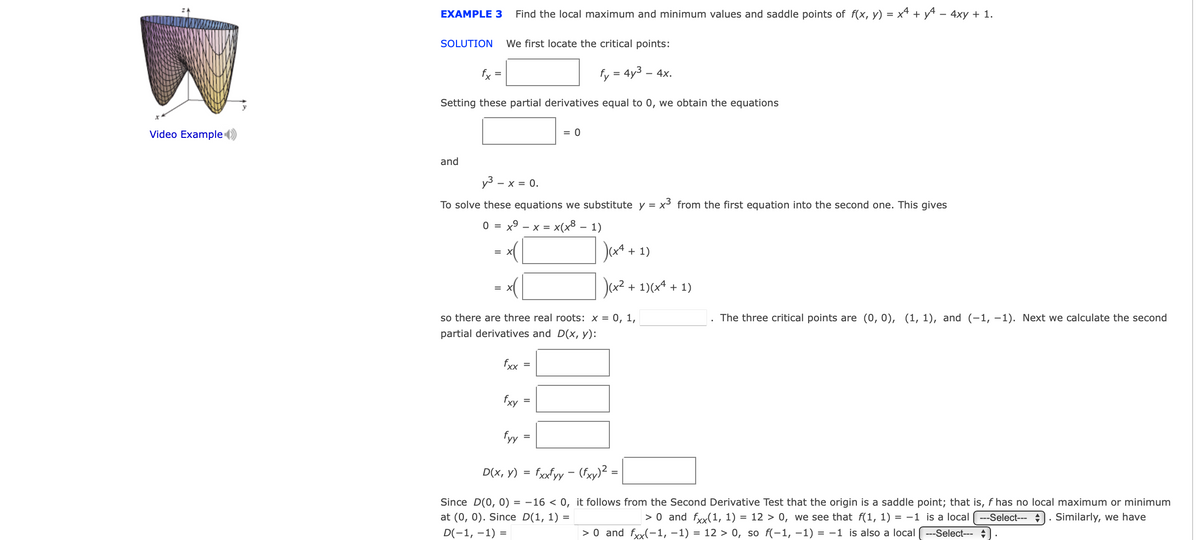Calculus: Early Transcendentals
8th Edition
ISBN:9781285741550
Author:James Stewart
Publisher:James Stewart
Chapter1: Functions And Models
Section: Chapter Questions
Problem 1RCC: (a) What is a function? What are its domain and range? (b) What is the graph of a function? (c) How...
Related questions
Question

Transcribed Image Text:EXAMPLE 3
Find the local maximum and minimum values and saddle points of f(x, y) = x4 + yA – 4xy + 1.
SOLUTION
We first locate the critical points:
fy = 4y3 – 4x.
Setting these partial derivatives equal to 0, we obtain the equations
Video Example
= 0
and
y3 - x = 0.
To solve these equations we substitute y = x³ from the first equation into the second one. This gives
0 =
= x9 - x = x(x8 - 1)
– x
+ 1)
=
+ 1)(x* + 1)
so there are three real roots: x = 0, 1,
The three critical points are (0, 0), (1, 1), and (-1, -1). Next we calculate the second
partial derivatives and D(x, y):
fxx
fxy
fyy
fxfyy
- (fxy)2 =
D(x, y)
Since D(0, 0) = -16 < 0, it follows from the Second Derivative Test that the origin is a saddle point; that is, f has no local maximum or minimum
at (0, 0). Since D(1, 1) =
> 0 and fy(1, 1) = 12 > 0, we see that f(1, 1) = -1 is a local ( ---Select-- :.
Similarly, we have
D(-1, –1) =
> 0 and fyx(-1, -1) = 12 > 0, so f(-1, -1) = -1 is also a local
---Select---
Expert Solution
This question has been solved!
Explore an expertly crafted, step-by-step solution for a thorough understanding of key concepts.
Step by step
Solved in 3 steps with 3 images

Knowledge Booster
Learn more about
Need a deep-dive on the concept behind this application? Look no further. Learn more about this topic, calculus and related others by exploring similar questions and additional content below.Recommended textbooks for you

Calculus: Early Transcendentals
Calculus
ISBN:
9781285741550
Author:
James Stewart
Publisher:
Cengage Learning

Thomas' Calculus (14th Edition)
Calculus
ISBN:
9780134438986
Author:
Joel R. Hass, Christopher E. Heil, Maurice D. Weir
Publisher:
PEARSON

Calculus: Early Transcendentals (3rd Edition)
Calculus
ISBN:
9780134763644
Author:
William L. Briggs, Lyle Cochran, Bernard Gillett, Eric Schulz
Publisher:
PEARSON

Calculus: Early Transcendentals
Calculus
ISBN:
9781285741550
Author:
James Stewart
Publisher:
Cengage Learning

Thomas' Calculus (14th Edition)
Calculus
ISBN:
9780134438986
Author:
Joel R. Hass, Christopher E. Heil, Maurice D. Weir
Publisher:
PEARSON

Calculus: Early Transcendentals (3rd Edition)
Calculus
ISBN:
9780134763644
Author:
William L. Briggs, Lyle Cochran, Bernard Gillett, Eric Schulz
Publisher:
PEARSON

Calculus: Early Transcendentals
Calculus
ISBN:
9781319050740
Author:
Jon Rogawski, Colin Adams, Robert Franzosa
Publisher:
W. H. Freeman


Calculus: Early Transcendental Functions
Calculus
ISBN:
9781337552516
Author:
Ron Larson, Bruce H. Edwards
Publisher:
Cengage Learning